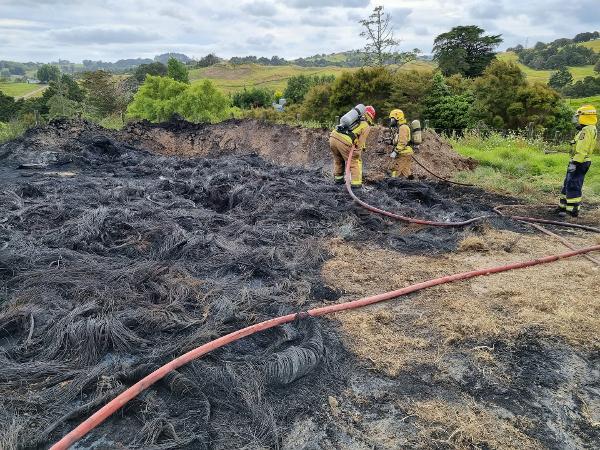$33,250 fine for tyre burning
A Northland man has been fined more than $33,000 for an incident that saw dozens of large tyres burnt on a property south of Kaiwaka in early January last year.
Bernard Glen Stewart, the lessee of the property, appeared for sentence before Judge DA Kirkpatrick in the Whangarei District Court recently (subs: 04 September).
Stewart had earlier admitted three charges relating to the incident; discharging contaminants into the air from the burning of tyres, discharging contaminants (the remains of burnt tyres) to land which may have seen the contaminants enter groundwater and discharging contaminants (the remains of burnt tyres) to land in contravention of the Proposed Regional Plan for Northland.
Judge Kirkpatrick’s sentencing notes reveal firefighters responded to a call from a neighbour about a fire on the property, which Stewart uses for grazing livestock, about 7.30pm on 06 January 2022.
Firefighters had found a smouldering pile with visible flames and smoke, an area of burnt material about 20 metres by 15 metres containing steel belts from tyres as well as discovering the remains of 100-130 tyres, most of which were large radius and possibly truck or tractor tyres.
Large amounts of melted rubber and steel belting from tyres was noted along with some unburnt tyres and about 13,600 litres of water were used to fully extinguish the fire.
Firefighters had notified the Northland Regional Council about the fire and the council had also received complaints from nearby residents.
On 10 January a council enforcement officer had spoken to Stewart and asked if he had burnt anything.
"The defendant said that he had burned fence posts and wires, and general farm stuff, and that a few tyres might have been scorched."
Later that same day enforcement officers had inspected the property noting it smelled of smoke, had been scraped clean and that there was an earth mound. "Attempts to excavate the soil to see what was buried were unsuccessful."
The officers had spoken to neighbouring residents who were worried about adverse health effects from ash and soot and said that Stewart had returned to the property early on 07 January and used a digger to bury the remains of the fire. He had also washed the roofs of the neighbours’ houses.
On 17 January, enforcement officers had interviewed Stewart who had told them there was a pile of waste that had been left by a previous tenant and he could not risk his stock getting tangled in the waste so had had to burn it as there was no other way to get rid of it.
"He burnt all farm rubbish including fence posts, plastic and electric fence connectors and there may have been some incidental tyres." He had not intended to burn tyres.
He had told council staff he did not know the rules about burning and did not know he was not allowed to burn tyres.
A report by a council air quality specialist from October last year on the potential adverse effects from burning tyres on the property had advised burning tyres released significant quantities of hazardous air pollutants into local air and produce large quantities of toxic oil which can contaminate soil, surface and ground water.
In early February 2022 the council advised one of the property owners the land had been added to the council’s "selected land use register for hazardous activities and industries list (known as its HAIL register) as ‘any other land that has been subject to the intentional or accidental release of hazardous substance in sufficient quantity that could be a risk to human health or the environment’."
An estimated 40 cubic metres of waste had been removed and disposed of in Northland’s Puwera landfill in mid-May this year after "lime stabilisation to reduce the mobility of zinc in the waste" but the property will remain on the HAIL register.
In submissions for the defendant, his lawyer had stressed Stewart had been cooperative with the council, "was engaged in remediation of the property and had paid for cleaning the roofs of neighbouring properties to address the potential effects on them".
The judge said the production of thick smoke with associated noxious fumes should make any person realise that burning tyres is unlikely to be a permitted activity.
"Taking that one step further, a person using land for farming activities should recognise that burying the remains of such a fire could have adverse effects, including the leaching of contaminants into ground water."
The judge said the court was aware that disposal of tyres "is not a simple matter".
"Even so, options for disposal do exist. In this case, it is not disputed that these tyres could have been disposed of at the Kaiwaka transfer station, some eight kilometres from the property, at a cost of $25 a tyre plus any transport cost."
The judge said when sentencing for environmental offending it was important to ensure "that the penalties are imposed which encouraged people to internalise the environmental costs of their activities rather than taking the risk of offending on economic grounds, such as by treating low levels of fines as a kind of licence fee".
He also noted that the fact the property was now a HAIL site "indicates the potential seriousness of this waste and should also serve as a deterrent to others, as it may reduce options for future land use, or increase the costs of future development on the property".
The judge said relevant mitigating factors had included Stewart’s cooperation.
"While he did not immediately take responsibility, his subsequent efforts at remediation and his previous good character warrant a (sentencing) discount of five percent." "I accept the submissions of counsel that his early guilty pleas justify a discount of 25%."
The judge said on that basis a total starting point of $47,500 for all three offences was reduced to $33,250.
That was made up of $20,000 for the burning offence and $6625 for each of the ‘burial’ offences. Court costs of $130 and a solicitor’s fee of $113 were also added on each charge.
Ninety percent of the fines will be paid to the regional council as prosecutor.

